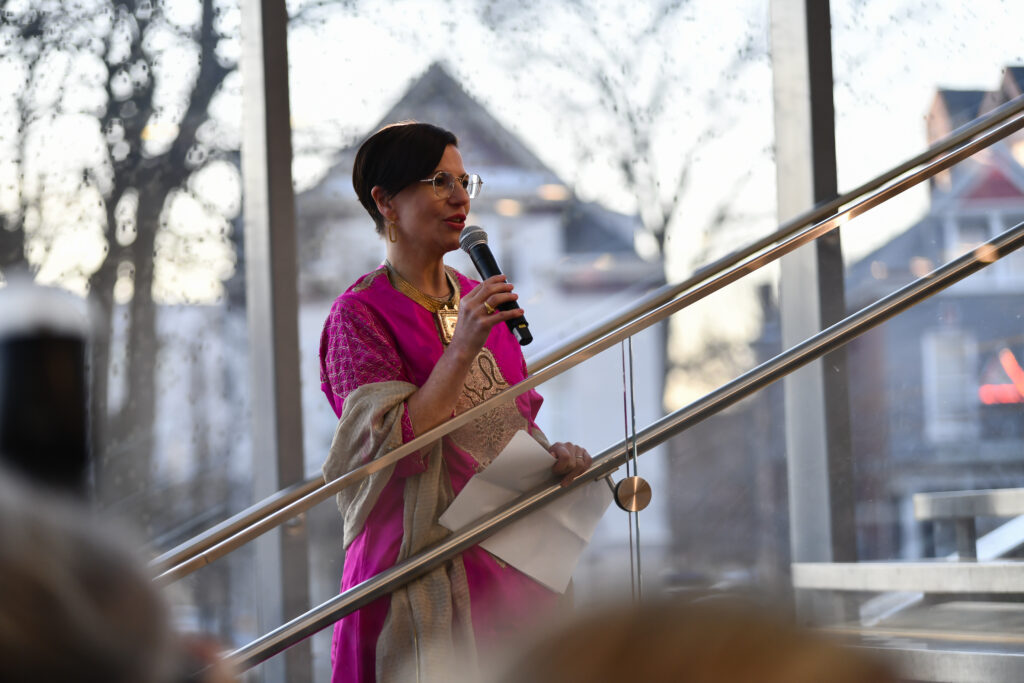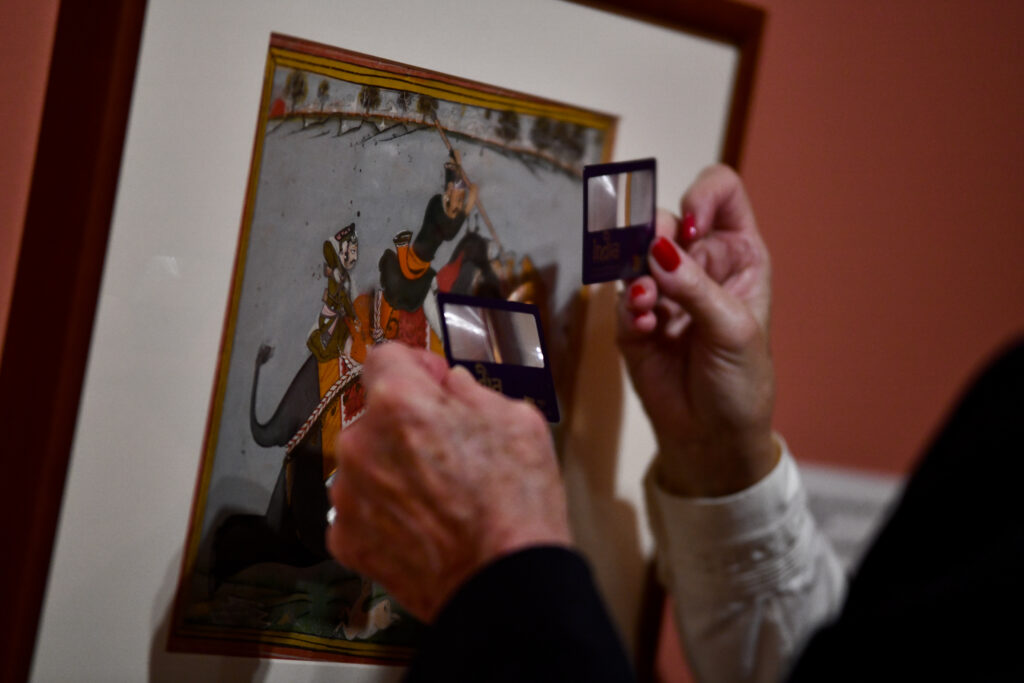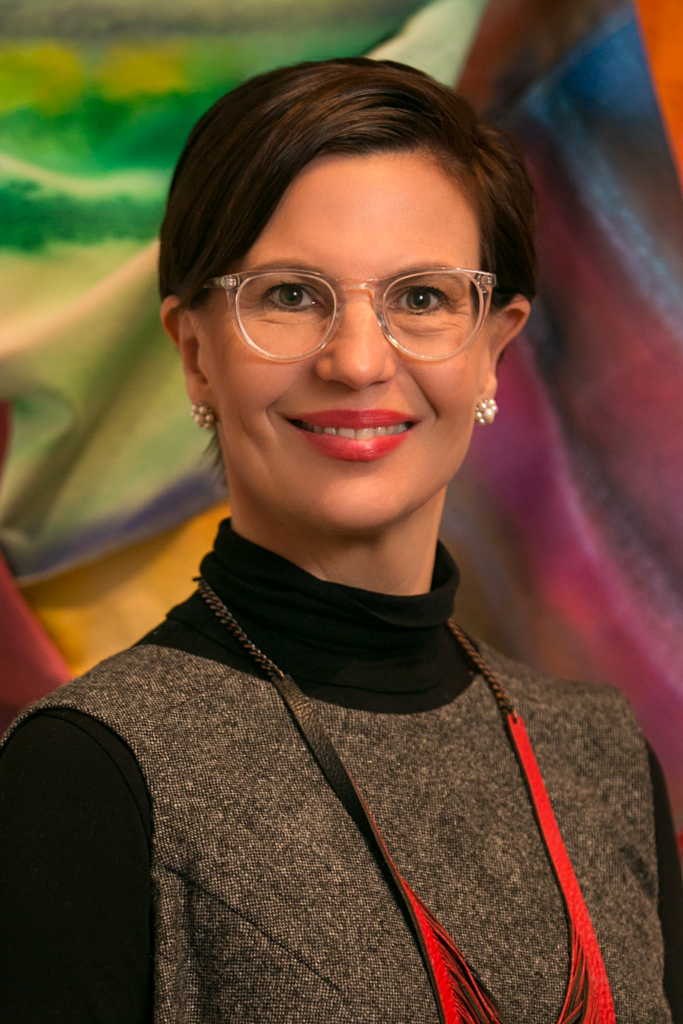
Director, Raphaela Platow address Speed Art Museum members and partners at the opening of India: South Asian Paintings from the San Diego Museum of Art. Photo by Kevin Sivakumar
The Speed Art Museum stands as a testament to artistic exploration and cultural immersion. Founded in 1927, the Speed is not only the oldest and largest art museum in Kentucky, but also boasts a vibrant and diverse collection that has been applauded by the deep appreciation for the arts in the community, fostering artistic dialogue and igniting imaginations for generations.
Audience publisher, G, Douglas Dreisbach, caught up with Director Raphaela Platow to hear more about her background, the importance of The Speed and the exciting new season of exhibits.
Listen to the full interview below:
G. Douglas Dreisbach: Tell us a little bit about you. How did you get into the arts and the curation of fine art at museums and all the exciting things that come along with it?
Raphaela Platow: From a young age, I just loved looking at pictures, all kinds of pictures …. Pictures in books, pictures in museums or sculptures or film or three-dimensional objects. And I’ve also always loved going to art museums. They’ve been, at times, places of contemplation for me and places that provided a deeper understanding to me about the world and about myself. I love museums as gathering spaces, and I love sitting in museum coffee shops and just wandering through the galleries with friends or by myself. Museums and art have just played a really big role in my life, from a young age on.
Early on, I did have thoughts about other professions. I thought, well, maybe I could be a lawyer or a chemist. I was kind of good in the sciences, and I think I’m a pretty analytical thinker. But I was very intrigued with art and museums. So, I did a lot of internships when I was in undergraduate school, and then more in grad school, and started working pretty early on in the arts. I just loved museums the most and kind of stuck with it. My background is in art history and in economics and business, and so I have literally been in it my entire life.

Members and partners at the opening of India: South Asian Paintings from the San Diego Museum of Art. Photo by Kevin Sivakumar
GDD: Most recently, you had a 14-year tenure at the Contemporary Arts Center in Cincinnati. How did you land there, and what was your time there like?
RP: I moved from Berlin in Germany, where I had lived for about seven years, to Raleigh, North Carolina, and then from there to the Boston area, and then to Cincinnati. I didn’t really know that much about Cincinnati, but the opportunity to work in one of the largest and oldest contemporary arts centers in the country was really intriguing to me. They had just built a phenomenal new building designed by Zaha Hadid, and had expanded quite a bit as an organization, so I really had the opportunity to think through how a contemporary arts center shaped a global program of exhibitions and performances and talks, but also how the institution could best serve its local audiences through a lot of programming, youth programming and family programming and adult programs, and be a viable and vibrant institution in the city.
I had a really great tenure there, and fell in love with the region — Louisville, Cincinnati, Lexington. I think from a landscape point of view and cultural point of view, it’s so amazing. Kentucky has such incredible natural beauty and so many amazing cultural and artistic tenets, both in literature and art. When the opportunity at the Speed came up, I was ready to go back to a museum that had a historic collection that was also committed to contemporary art, and the Speed just seemed like a perfect opportunity.
GDD: Why do you feel the vested interest in not only the community being a part of the arts, but also having access to the museum through free admission opportunities and other programs?
RP: As cultural organizations, we have to serve all of our audiences, not just a particular slice of our audiences. Everybody, in my mind, should have the right to see incredible art from around the world, and have the opportunity to experience different cultures and different eras through the lens of art and the creative process, and through culture. This is why I think making an institution accessible to everybody and reducing financial, physical, and emotional barriers has always been important to me, to shape institutions that are inclusive and that are accessible.
Art and artmaking is what uniquely, of course, differentiates us from other species. We are born with this innate ability to be creative and to imagine our futures, imagine our lives differently or the same for better or worse, whatever it may be. And bringing people into that space, where artists throughout time and around the globe have been, they can experience what they have imagined and how they reflected their contemporary world, what they were struggling with, what they were drawn to, what they were repelled by, because artists are part of the present moment in whatever time they live. They are incredible gauges of our societies, of our cultures, and I find that to be a very powerful lens on reality that should be accessible and available to everybody.
GDD: Looking at the exciting exhibit lineup for the new season at the Speed, it looks like a great reflection of different parts of our heritages and things around the world. Can you tell us a little bit about the upcoming season and what you’re excited about?
RP: I am excited about all of them, because of course, as art professionals, we make choices about what we believe our audiences would love to see. And so, we fully believe that everything we are doing and everything we are showing will resonate in different ways. The exhibition we just opened, India, is the first South Asian exhibition ever at the Speed. I think it is important that we as an arts institution bring cultures from around the globe to Louisville, to us at home, so that everybody can see what people in different eras created.
This is a truly special exhibition. … The blending of creativity from Persia and then, of course, Hinduism, so Islam and Hinduism, was just magnificent. … The craftsmanship is truly mind-blowing so I hope that many people will have the opportunity to see it.
A little bit later in the year, in June, we are opening a wonderful project by Yayoi Kusama, a contemporary Japanese artist, who is probably one of the most well-known female Japanese artists in the world. We have one of her mirror infinity rooms at the Speed that people will get to enjoy. There hasn’t really been one in our broader region, so we very much look forward to that.
We are also working with an advisory committee on the re-installation of our Native American collection. Our curator, who oversees those collections, Dr. Fari Nzinga, has spent many months developing relationships with elders of the tribes whose objects we have at the Speed, at other cultural bearers here in Louisville, and then also within the Oglala Lakota tribe.
Then, the exhibit with Timothy O’Sullivan is fantastic. He was just an incredible photographer of the United States, and he photographed quite a bit during the time of the westward movement. We are showing some incredible sepia prints and black-and-white photographs that he took of important historic sites such as the Native American dwellings in the Cañon de Chelly and other incredible natural landscapes that people discovered as they were further discovering the beauty and the plethora of cultural sites as they were moving further towards the west.
These are just a few highlights of what’s coming up. Of course, we always have many programs going on weekly, from family-accessible to all kinds of kids’ and family programs. And then, of course, our phenomenal cinema program and talks and lectures and After Hours events. You could be at the Speed every day and get to experience a whole new set of wonderful things to do.

Visitors explore the details of a painting from India: South Asian Paintings from the San Diego Museum of Art. Photo by Kevin Sivakumar
GDD: What goes into the planning and implementation for creating a season of exhibits?
RP: It is quite a process. For very large exhibitions, such as the Mughal paintings that came to us from the San Diego Museum of Art, we plan several years ahead of time, just because loans have to be requested, and there’s a lot that has to be orchestrated and agreed upon and pulled together. We also published a catalog together with the show, so all of that takes time.
Exhibitions that we pull from our own collection, we can move a little bit faster with those, such as Timothy O’Sullivan. But when we think about a year of exhibitions, we really think about the different artistic and cultural experiences that we are offering our audiences. We want it to be varied. We don’t want it to be all of the same, let’s say, intellectual pursuit or interest. We are trying to provide a very varied program, so that everybody who comes to the Speed has something to explore that they really love.
GDD: In closing, is there anything you’d like to add?
RP: We are in the middle of building a really beautiful green space for the community that will be filled with native plants and flowers and bushes and art. When you come to the Speed over the next few months, you will see some construction fencing and some workers hard at work, landscaping the green space around the Speed, but it’s still very easy to get to the entrance.
For more information, visit SpeedMuseum.org






